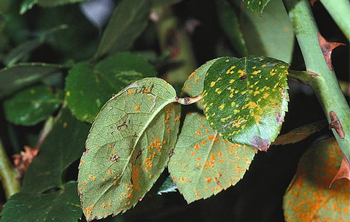Rust
-
AboutFungal disease named for the dry to gelatinous, orange, reddish, or yellowish fruiting bodies and spore masses that many species form on infected tissue. Rusts infect many hosts, including birch, cedar, cottonwood, cypress, fuchsia, hawthorn, juniper, pear, pine, poplar, rhododendron, and rose.
 Photo: UC ANR
Photo: UC ANR -
Category
-
Fungi
-
-
Signs/Symptoms
Discolored spots on leaves, which may drop prematurely. Infected foliage on broadleaf hosts may become spotted, turn yellow or brown overall, and drop prematurely. Infected conifers may develop bushy growth (e.g., witches' brooms), cankered, galled, and oozing bark and limbs, and spotted needles.
-
Where
On fruit, green stems, and leaves of broadleaf plants or on the bark or needles of conifers.
-
When
Infects hosts when plant surfaces are wet and temperatures are mild, mostly during the fall to spring or almost any time of the year in coastal locations. Rust fungi are spread primarily by windblown spores and when infected plants (e.g., from a nursery) are moved. Each species of rust is specific to certain hosts.
-
Prevent
Plant rust-resistant cultivars if available. Avoid overhead watering.
-
Manage
Collect fallen, infected leaves and needles and dispose of them away from host plants. Cut off and dispose of diseased shoots and branches as soon as they appear, except do not prune woody parts so extensively that plants are seriously damaged. Removing nearby alternate hosts of the fungus may help to reduce new infections in certain situations.
-
More Information

